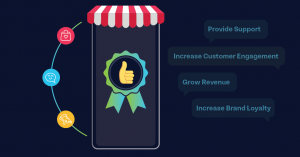
Everybody communicates using their phones these days. It’s how we chat to friends and family, how we read news and interesting information, and how we complete our banking and other administrative tasks. So it makes sense that customers are going to use their phones to communicate with the brands that they use daily. That’s why it’s important for businesses to have a solid social media strategy plan in place. We’ll look at what exactly that is and how you can implement one for your business.
What is a social media strategy plan?
This is the summary of everything you plan to do and what you hope to achieve by using social media in your overall digital marketing strategy. In this document you’ll outline which social media platforms you choose to use and go into detail about the goals you have for them. Do you hope to increase your follower numbers? Do you hope to answer each question posted by customers? Do you hope to become an industry expert? Do you hope to increase sales? The more specific you are with your plan, the more likely it’ll be that you’ll achieve these goals.
Which social networks do you need to be on?
Each platform is unique with its own style, audience, and best practices. You don’t need to be on them all. You just need to be on the social networks where your audience is. The social networks which you should be on should align with your goals and mirror where your audience spends their time. Pew Research Center has complete data of the demographics for Facebook, Twitter, Instagram, Pinterest, and LinkedIn.
Related: Follow us on Twitter @Clickatell, or join us on Facebook
It’s important that you understand from the start how much time you have to allocate to social networking. You need at least an hour per day per social network at the start of your social media journey. In addition, you need to have the resources to create the content and posts. Do you have people who can assist with writing, graphic design and video creation? You’ll need to be clear on the type of content you're going to post and how it’s going to be sourced or created. Research has found that the optimum mix between curated or created content is a mix of 50% to 75% in favor of curated content.
Find your voice and tone
It’s important that you’re clear from the beginning about the voice and tone of your social media posts and customer interactions. You’ll need to ask yourself about the “personality” of your brand and the “relationship” your brand has with customers. Are you serious or playful? Entertaining or informative? You need to understand this from the start so your brand’s identity is consistent across all platforms.
Decide on your posting strategy
What should you post, when should you post and how often should you post? There’s no single correct answer. But there are some examples of best practice which you can follow. For instance, posts that contain an image always perform better than those without images. There are some guidelines about how often to post. Examples include five to 10 times per week on Facebook, five times per day on Twitter, once a day on LinkedIn and up to five times per day on Google+. Typically, the best times to post are at the start and end of work days, during lunchtime and in the evening between dinner and bedtime. This is when the majority of people are typically scrolling through social media. But the problem comes in when you consider that your clients and audience could be anywhere in the world, in any time zone. It’s important that you analyze where the majority of your audience is so that you’re posting when they’re online.
Analyze the data
Now that you’ve decided where, what, and when you’re going to post, you need to proceed for a few weeks and then analyze the data. Using social media monitoring, you need to check whether your posts are being liked and shared. Facebook and Twitter both have built-in analytics available on their platforms which makes analyzing your data simple. Check for which posts are performing well, where you’re getting the highest engagement and at what times your audience is most engaged. By analyzing your data often, you’ll be able to discover what works and refine your content strategy.
Automate and engage
To make your social media strategy simple and painless, it’s best to automate your posts. There are a good few tools that allow you to create all the posts you want to and schedule them for posting. Automation is the key to consistent and engaging posting. You’ll also want to schedule time for engagement and social media monitoring. Engaging with followers and fans on a regular basis is how you’ll begin to build your community.
If you’re interested in learning more, click through to our Twitter page, @Clickatell, or our Facebook page where there’s a constant conversation around these topics.
Explore other articles
Step into the future of business messaging.
SMS and two-way channels, automation, call center integration, payments - do it all with Clickatell's Chat Commerce platform.








